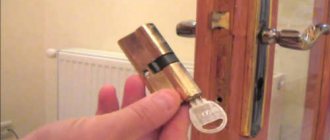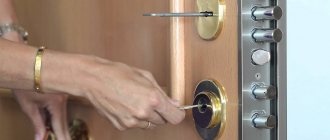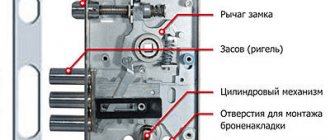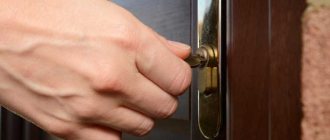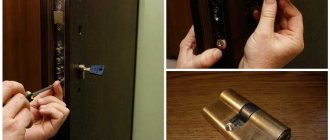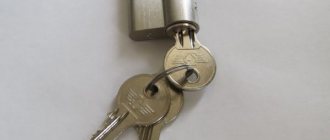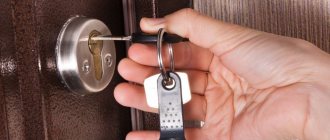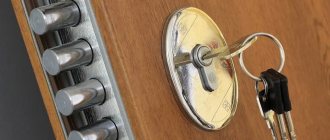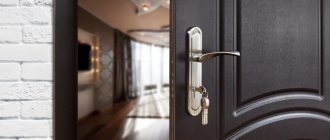- Posted by Alexander Kostyuk
- Date: May 15, 2018
Timely replacement of the cylinder will help prevent lock damage. It is this mechanism that is responsible for controlling the lock, identifying the key, and opening access to the rotary mechanism, which moves the locking tab. Apart from rare cases of breakage of the lock springs, the cylinder ranks first in terms of wear and tear - after all, it is used most often, several times a day.
- 2 Types of lock cylinders
2.1 How to choose a new lock cylinder2.1.1 Video: how to choose a lock cylinder
- 4.1 Necessary tools for replacing and repairing the lock cylinder
4.3.1 Video: replacing the cylinder in a mortise lock
- 4.5.1 Video: repair of a rim lock
When to change the larva
The cylinder is the lock's coding mechanism, which serves to identify the key. The locking mechanisms of all locks are designed approximately the same, the only difference is in the “secret”, which determines which key is suitable and which is not. Thanks to this device, secrecy is ensured: the door can only be opened with a key that is at the disposal of the owners of the house or apartment.
The uniqueness of each larva lies in the set of pins located inside the cylinder
As a rule, locks last a very long time. But there are exceptions to every rule. Sometimes, for one reason or another, the mechanism fails and the process of closing or unlocking becomes difficult. The key does not turn, sticks, jams. Or vice versa - it rotates easily, but the lock tongue does not move. There are times when the key cannot be inserted into the hole, and sometimes, on the contrary, it is impossible to get it out. The reasons for this behavior of the lock are different:
- natural breakdown of the mechanism due to wear of parts;
- directed external influence, mechanical damage, impact;
- attempts to open the door with another key or without a key at all;
- breaking into;
- clogging of the keyhole with foreign objects, debris, rust.
In all these cases, immediate replacement of the larva is necessary. If you do not do this in a timely manner, at one point you may find yourself in front of the door to your own apartment, which is impossible to enter.
Another common reason for replacing cylinders is the loss (or theft) of keys. According to key masters, most cases of loss occur on weekends and holidays.
To restore the operation of the lock, in the vast majority of cases it is not necessary to change it entirely . It is enough to purchase a new cylinder with a set of keys and install it in place of the old one. This kind of work is easy to do yourself with the help of simple tools. But sometimes it is better to turn to professionals; below we will consider such cases in more detail.
Design features
The design of any shutter device includes the following components:
- Larva;
- Crossbars;
- Tongue;
- Door knob;
- Response panel;
- Decorative strip.
Models for interior units are often limited to only a latch. They do not have a secret mechanism. And entrance structures must have reliable shutter fittings.
Therefore, all locks are divided into separate categories according to the degree of secrecy of the locking mechanism. The reliability class is characterized by the number of possible combinations of the device secret itself. The more of them there are, the more difficult it is to open the lock using master keys.
Many manufacturers also produce special locking mechanisms that are burglar-resistant. Some of these models can only be opened using the original key.
What malfunctions of the larva can be repaired without replacement?
From time to time (at least once a year), the larva needs to be cleaned and lubricated. This will protect it from malfunctions. Liquid lubricant (type VD-40) not only flushes the working cavity, but also lubricates the rubbing parts - pins and pins. But after such “washing” it is recommended to additionally lubricate the larva with graphite lubricant.
Universal household lubricant with low viscosity is guaranteed to eliminate dry areas in the locking mechanism
If foreign objects get inside the larva - matches, paper clips, etc., they need to be removed and the larva is blown out with a vacuum cleaner. It is convenient to use a magnet to remove small metal objects.
The most unpleasant thing that can happen is that a hardening liquid mixture gets into the keyhole - diluted cement, acrylic or silicone sealant, polyurethane foam or banal chewing gum. After hardening, these substances turn into a monolithic mass, which is almost impossible to extract. Previously, such “tricks” were used by hooligans who wanted to harm residents. In such cases, the larva has to be changed. To protect the keyhole from ill-wishers, a screen is installed inside the core, which is fixed with a steel spring.
Cross-shaped, pin and special complexity secrets
Cross-type cylinders use pins that line up along four edges when the key is turned. As a rule, they are distinguished by a large number of code combinations, but the bulk of inexpensive products can be broken into with a regular cross-head screwdriver.
The cylinder is difficult to change and requires dismantling the lock. In this regard, experts do not recommend doing this, but advise changing the lock immediately. Pin cylinder lock cylinders are produced for two types of keys:
- English.
- Perforated.
The first is neither reliable nor confidential. To open the second type, you will have to drill or knock out the cylinder. This requires tools, time and creates quite a lot of noise. It is perforated cylinders that are most often found on entrance door locks.
The mechanisms of the larvae become more complex every year. Lock manufacturers spare no effort and money spent on increasing the security of their products. Modern technologies, new materials and high-precision processing methods make it possible to create unique mechanisms that are reliable and durable. The larvae of modern expensive high-quality products have the following protective arsenal in their design:
- Armor inserts.
- Titanium case.
- Secrecy - more than a million combinations.
- Pins made of refractory metal.
- Floating elements on the key.
It is possible to find a key to such a lock, but it will require a lot of time, effort and skills. Replacing the larva is also quite possible. However, given its high cost, this may become a problem for many.
Caring for the lock cylinder (expert advice)
In order for the castle to serve for a long time and without surprises, you need to give it a little attention at least once a year. First of all, this concerns cleaning the larva from contamination. Contact with the external environment: dust, moisture and temperature changes - all this affects the operation of the lock. Sooner or later, dirt accumulates and the lock may simply jam.
Lock flush is poured directly into the keyhole
Experts recommend periodically (depending on operating conditions) washing the internal cavity of the larva. There are special liquids for this that are easy to find in specialized stores and key repair shops. The washing procedure is quite simple:
- cleaning spray from a can is poured into the larva;
- the key is inserted to the full depth;
- the key is removed and cleaned of adhering dirt.
This operation is performed until the key is completely cleaned. After preventative maintenance on the inside of the door, the same is done on the outside.
The key must not be rotated during cleaning. This will cause debris to spread throughout the cylinder mechanism. Only forward and backward movement is allowed.
If the lock on the front door needs to be cleaned, it is advisable to select a washing liquid with water-repellent and frost-resistant properties.
After cleaning the lock from dust and dirt, the key is dipped in lubricant, inserted into the cylinder and turned in different directions. In this case, the oil penetrates the core and lubricates the pins, springs and pins. Machine (motor) or spindle oil is most often used as a lubricant. But it is better to use a special lubricant designed specifically for locks of this type. Excess lubricant is removed with a rag.
Selecting a lock by installation method
Photo: Types of door locks
Modern locking devices are divided into three types:
- mounted;
- invoices;
- mortise
And if the installation of a padlock requires only the presence of hinges, then the installation of a door lock with a handle requires a stationary insertion using a specialized tool.
Conclusion
Finally, I would like to answer a frequently asked question regarding self-repair of the mechanism. So, repairing the lock cylinder at home is impossible. More precisely, you can repair it; the key will turn, but the cylinder will begin to open even with a pin. So only replacing the cylinder will help.
Repairing the larva of a house is difficult, almost impossible.
Kinds
The secret mechanism for entrance doors has several classes of complexity. They are one- or two-sided. The first type of device is characterized by a door lock that can only be opened unilaterally. In the second case, the device is unlocked from both the inside and the outside; this is done with a key and on the other with a handle.
The mechanism may have several pairs of return springs. Spring-loaded pins come in several types:
- codes with which the key interacts;
- locking, have locking mechanisms.
Model with a handle on one side
Based on the location, there are several types:
- Double-row and single-row mechanisms.
- Three- and four-row.
- With conical arrangement.
- With rotating pins.
Based on the type of mechanism, the cylinder can be:
- Secret with a disk mechanism.
Cylinder with disc mechanism
- Secret with a cross-shaped pin.
Diagram of a cylinder with a cross-shaped lock
- Pin mechanism
It is important! The latest model can have several configurations: electronic cylinder or magnetic.
As an example, here are several privacy mechanisms with 9 or more pins:
- NK mechanism, 120 mm (60x60).
- NDT device, 60 mm (30x30).
- Product NK for 70 mm (30x40).
- NDT device for 70 mm (40x30).
- Product DF 70 mm (40x30).
- Product XD 70 mm (13 pins).
Security mechanism HK 120 (60×60)
The main models of mechanisms have a size of 60 mm, and Italian-made security mechanisms have a size of 70 mm.
The front door cylinder can have several levels of privacy:
- low when the castle has 10 thousand options;
- medium, when there are 50 thousand options;
- highest, when the castle has more than 100 thousand options.
How to buy the perfect cylinder
There are many types of cylinders, distributed according to the level of secrecy and reliability, resistance to force. The main parameters that you first need to pay attention to are:
- ease of operation;
- durability and wear resistance;
- reliability.
How wear-resistant the lock is directly depends on the quality of the internal components of the product, as well as the materials from which they are made. The lubricant used in the device must be taken into account.
If we add here the build quality of the components and the entire device as a whole, then we can talk about the reliability of the mechanism. The higher the reliability and wear resistance of the cylinder, the lower the likelihood that at some point it may refuse to function or will be opened with a master key.

